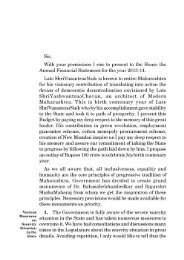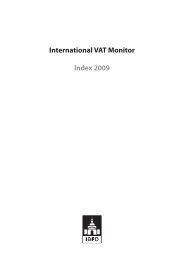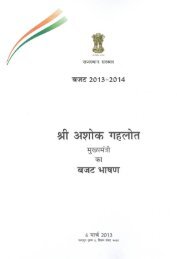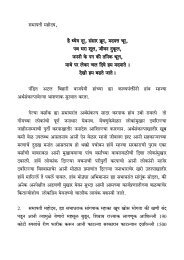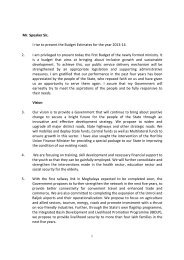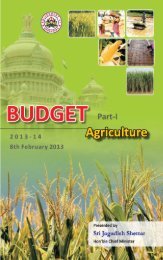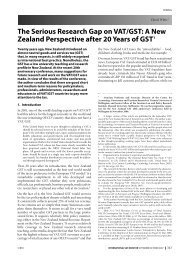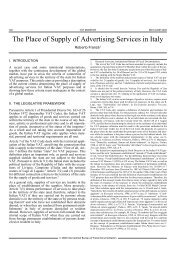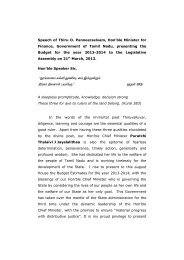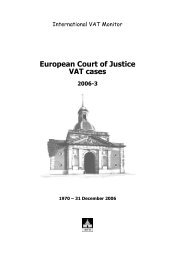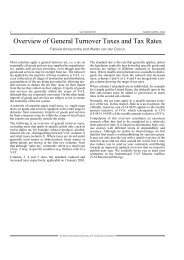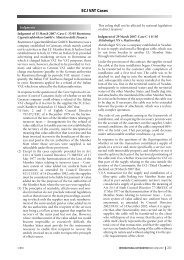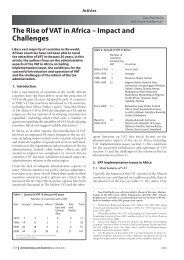VAT 99-2/final - empcom.gov.in
VAT 99-2/final - empcom.gov.in
VAT 99-2/final - empcom.gov.in
You also want an ePaper? Increase the reach of your titles
YUMPU automatically turns print PDFs into web optimized ePapers that Google loves.
Vol. 10 No. 2, March/April 1<strong>99</strong>9 <strong>VAT</strong> MONITOR 69<br />
very hostile to <strong>VAT</strong> from the very beg<strong>in</strong>n<strong>in</strong>g16 . While they<br />
could not challenge the pr<strong>in</strong>ciple of <strong>VAT</strong>, they were<br />
repeatedly say<strong>in</strong>g that this tax could not be implemented <strong>in</strong><br />
Nepal for several reasons. They raised several issues such<br />
as <strong>VAT</strong> is not suitable for Nepal, it is <strong>in</strong>flationary, it is<br />
complicated and it will encourage corruption. But these<br />
charges could not catch the sentiment of the mass, which<br />
was <strong>in</strong>formed on different aspects of <strong>VAT</strong> through an<br />
extensive taxpayer education programme. F<strong>in</strong>ally, the<br />
bus<strong>in</strong>ess community demanded that <strong>VAT</strong> be <strong>in</strong>troduced<br />
from the beg<strong>in</strong>n<strong>in</strong>g of the next fiscal year (i.e. from 16 July<br />
1<strong>99</strong>8 <strong>in</strong>stead of 16 November 1<strong>99</strong>7) and the sales tax rate<br />
prescribed for the imports by non-registered persons<br />
should be reduced from 20% to 15%. They also demanded<br />
the cont<strong>in</strong>uation of all exemptions granted under the sales<br />
tax system.<br />
On 18 November 1<strong>99</strong>7 <strong>gov</strong>ernment officials and the<br />
FNCCI representatives reached an agreement on <strong>VAT</strong><br />
issues, <strong>in</strong>clud<strong>in</strong>g the creation of a technical committee <strong>in</strong><br />
order to identify different problems met <strong>in</strong> the course of<br />
implement<strong>in</strong>g <strong>VAT</strong>, to form a permanent revenue board,<br />
and cont<strong>in</strong>ue with the facilities granted under the sales tax<br />
for 3 months. Under this agreement, all tax exemptions<br />
and <strong>in</strong>centives granted under the sales tax system were<br />
granted under <strong>VAT</strong> as well for 90 days and a technical<br />
committee was created on 15 December 1<strong>99</strong>7. Representatives<br />
of the bus<strong>in</strong>ess community presented to the committee<br />
for discussion several issues such as the customs<br />
valuation, <strong>VAT</strong> and <strong>in</strong>come tax treatment of stock, the<br />
time period for the declaration of stock, a review of the<br />
exemption list, the possibility of limit<strong>in</strong>g <strong>VAT</strong> only to<br />
imports or the wholesale stage, reform of customs duties<br />
and <strong>in</strong>come tax, partial <strong>VAT</strong>, penal provisions and creation<br />
of a permanent Revenue Board.<br />
Some of these concerns were genu<strong>in</strong>e while others were<br />
ridiculous. For example, the demand for the improvement<br />
<strong>in</strong> the customs valuation system was genu<strong>in</strong>e. This is<br />
because the Customs Department fixes values for customs<br />
purposes. These values are lower than the actual values of<br />
some commodities while higher than the actual values of<br />
others. In the case of overvaluation, taxpayers have to pay<br />
more <strong>VAT</strong> than actually required, while <strong>in</strong> the case of<br />
undervaluation they have to pay less <strong>VAT</strong> than actually<br />
required. Such an unrealistic valuation system has made it<br />
difficult to ma<strong>in</strong>ta<strong>in</strong> proper accounts. This is because <strong>in</strong><br />
the case of undervaluation, importers have to show a lower<br />
value than the actual purchase price <strong>in</strong> the purchase book.<br />
The importer fixes his sell<strong>in</strong>g price on the basis of the<br />
actual price he has paid, not on the basis of the value fixed<br />
for customs purposes. This leads to an artificially high<br />
value added and high profit and hence high <strong>in</strong>come tax liability.<br />
Because of this importers did not issue an <strong>in</strong>voice<br />
show<strong>in</strong>g actual sell<strong>in</strong>g prices, rather they stated much<br />
lower prices on <strong>in</strong>voices than they actually charged. On<br />
the other hand, <strong>in</strong> the case of goods subject to overvaluation,<br />
importers had to pay high tax and later on claim a<br />
refund. This created not only a cash flow problem but also<br />
difficulty <strong>in</strong> gett<strong>in</strong>g a refund s<strong>in</strong>ce tax officials treat cases<br />
© 1<strong>99</strong>9 International Bureau of Fiscal Documentation<br />
of tax credit with suspicion. Because of this problem,<br />
traders tried not to come under the <strong>VAT</strong> net. So customs<br />
valuation has been an impediment to the smooth and transparent<br />
runn<strong>in</strong>g of <strong>VAT</strong>. The bus<strong>in</strong>ess community<br />
demanded the abolition of the customs valuation system.<br />
Another problem was the <strong>VAT</strong> and <strong>in</strong>come tax treatment<br />
of stock. Accord<strong>in</strong>g to the <strong>VAT</strong> regulations, only the sales<br />
tax paid on purchases made with<strong>in</strong> 1 year rema<strong>in</strong><strong>in</strong>g <strong>in</strong><br />
stock at the commencement of the <strong>VAT</strong> Act was allowed<br />
to be deducted <strong>in</strong> the case of the follow<strong>in</strong>g goods:<br />
– on goods bought by taxpayers for resale;<br />
– on goods and services partially produced or ancillary<br />
goods for the bus<strong>in</strong>ess;<br />
– on raw materials, auxiliary raw materials, and pack<strong>in</strong>g<br />
materials.<br />
A taxpayer may submit an application to the tax officer <strong>in</strong><br />
the prescribed form to have a deduction of sales tax paid<br />
by him on his stock of goods at the time of registration.<br />
These goods must have been purchased dur<strong>in</strong>g the last<br />
year. He is also required to submit <strong>in</strong>voices of payment of<br />
sales tax and other documentary evidence with<strong>in</strong> 15 days<br />
of registration. There is no provision allow<strong>in</strong>g <strong>in</strong>put tax<br />
credit <strong>in</strong> the case of goods that were <strong>in</strong> stock but did not<br />
meet these criteria. In such cases there was a possibility of<br />
double taxation and consequent price rises.<br />
Treatment of stock was a problem from the po<strong>in</strong>t of view<br />
of <strong>in</strong>come tax also. This is because <strong>in</strong> the case of imports<br />
from third countries, <strong>in</strong>come tax is also assessed on the<br />
basis of import documents. This means that importers<br />
have to pay <strong>in</strong>come tax on the stock of imported<br />
goods. The bus<strong>in</strong>ess community demanded that they<br />
should not be asked to pay <strong>in</strong>come tax aga<strong>in</strong> on such<br />
<strong>in</strong>come tax paid stock.<br />
The bus<strong>in</strong>ess community also demanded a reduction <strong>in</strong> the<br />
customs and <strong>in</strong>come tax rates. This was particularly<br />
important <strong>in</strong> the context that taxpayers would have to pay<br />
full tax <strong>in</strong> the post-<strong>VAT</strong> regime through the availability of<br />
the <strong>in</strong>formation on the bus<strong>in</strong>ess transactions of taxpayers<br />
under the <strong>VAT</strong> system. The bus<strong>in</strong>ess community at large<br />
was also scared of the transparency to be generated by the<br />
<strong>VAT</strong> system. This was also of concern to many tax collectors.<br />
Another concern of the bus<strong>in</strong>ess community was penal<br />
provisions. They considered that the penal provisions<br />
under the <strong>VAT</strong> law were very str<strong>in</strong>gent and the tax officials<br />
would threaten them with such severe penalties.<br />
The bus<strong>in</strong>ess community also demanded an unusual type<br />
of <strong>VAT</strong> system, i.e. that for some selected commodities,<br />
<strong>VAT</strong> should be levied at each stage <strong>in</strong> the process of production<br />
and distribution without any threshold; for others,<br />
<strong>VAT</strong> should be limited to the import/manufactur<strong>in</strong>g po<strong>in</strong>t,<br />
other items should be exempted from <strong>VAT</strong> and the tax<br />
should be levied only <strong>in</strong> some parts of Nepal, not every-<br />
16. The Nepal Chamber of Commerce set up an Anti-<strong>VAT</strong> Action<br />
Committee, which called for strikes several times.



